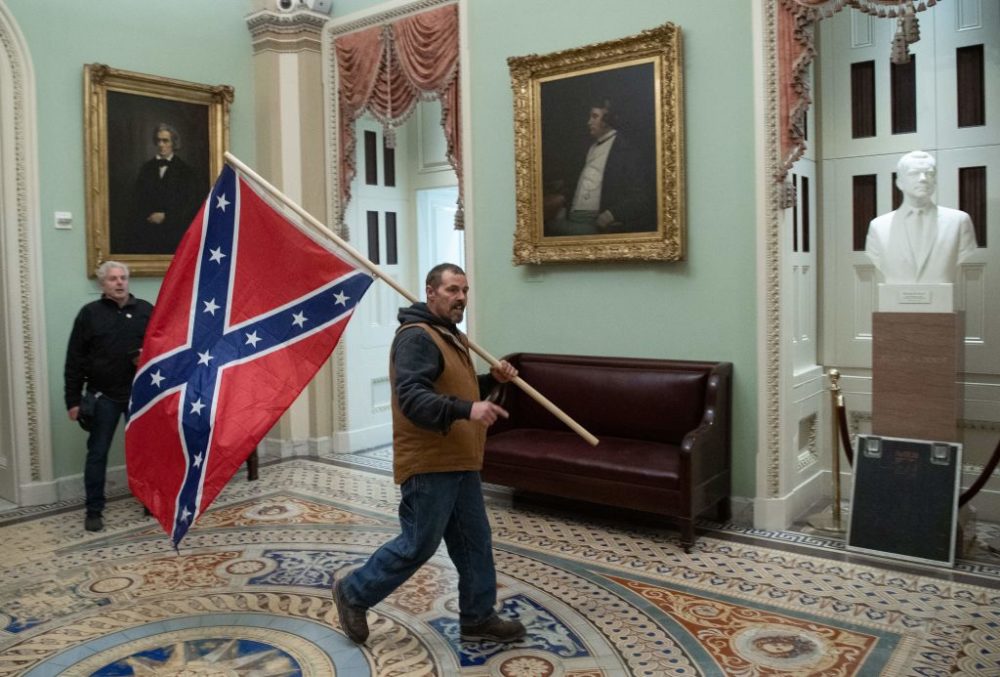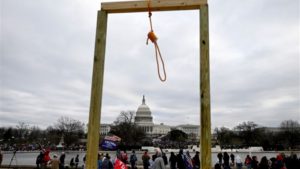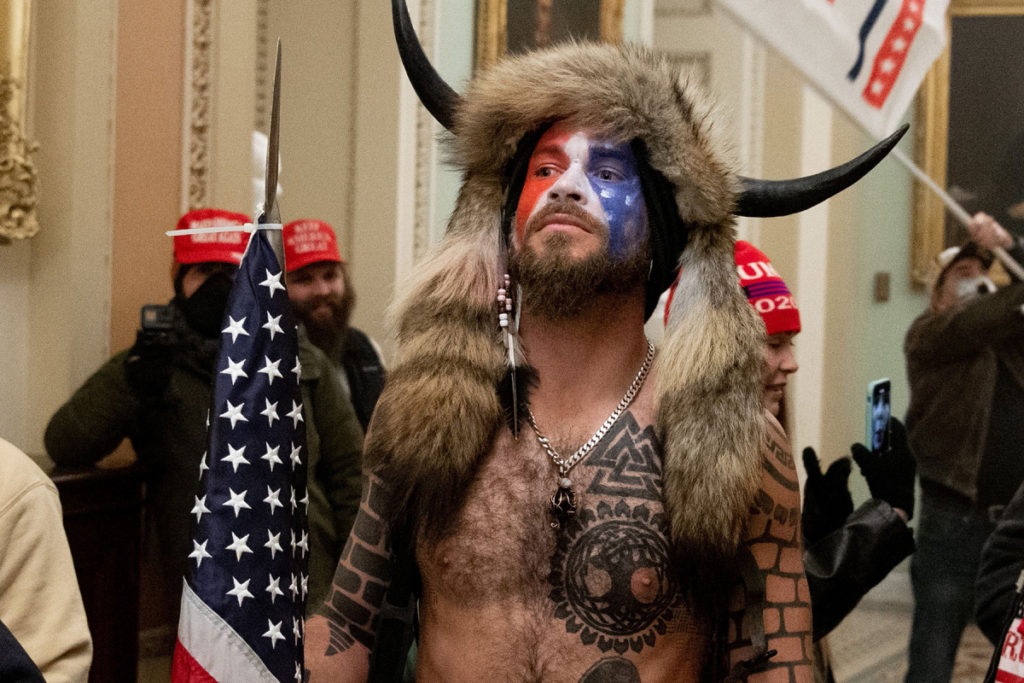The Fourteen Words: Religion and Racism in White Nationalist Domestic Terrorism
January 6, 2021 was not simply about an election. It was about maintaining a white ethnostate.

Kevin Seefried stormed the Capitol with the Confederate flag in hand. (Photo: Saul Loeb for Getty Images)
In December 2020, instead of preparing to exit the White House gracefully, then-President Donald Trump tweeted, “Statistically impossible to have lost the 2020 Election. Big protest on January 6th. Be there, will be wild!” In response, the FBI reported that online white nationalist groups planned and discussed violence, including posts such as, “Be ready to fight. Congress needs to hear glass breaking, doors being kicked in, and blood from their BLM and Pantifa [sic] slave soldiers being spilled. Get violent. Stop calling this a march, or rally, or a protest. Go there ready for war. We get our President or we die. NOTHING else will achieve this goal.”
On January 6, 2021, the U.S. Capitol was invaded in a coordinated attack along with state capitols across the country by white nationalist domestic terrorists. Lawmakers were the target. Indicating the level of preparation in advance of their mission, rioters, after successfully entering the Capitol, sent messages to Thomas Edward Caldwell, former Navy veteran and leader of the Oath Keepers, a white nationalist group. One read, “All members are in the tunnels under capital [sic] seal them in. Turn on gas.” The violence resulted in five deaths.
 As a scholar of systemic racism, white nationalism, and militant Islamism, the U.S. Capitol attack was not surprising. It was also about more than a “stolen election.” Though many were quick to label Donald Trump as the cause of the white nationalist domestic terrorism, he is but a symptom of the centuries-long desire to maintain and reclaim the United States as a nation of white people, by white people, and for white people, which can be traced back to the nation’s founding. January 6, 2021 was a battle in defense of the white race against physical and cultural annihilation in the war to establish a white ethnostate.
As a scholar of systemic racism, white nationalism, and militant Islamism, the U.S. Capitol attack was not surprising. It was also about more than a “stolen election.” Though many were quick to label Donald Trump as the cause of the white nationalist domestic terrorism, he is but a symptom of the centuries-long desire to maintain and reclaim the United States as a nation of white people, by white people, and for white people, which can be traced back to the nation’s founding. January 6, 2021 was a battle in defense of the white race against physical and cultural annihilation in the war to establish a white ethnostate.
As I discovered over the course of a decade researching my forthcoming book, Homegrown Hate: Why White Nationalists and Militant Islamists are Waging War against the United States, the constellation of white nationalist domestic terrorism is vast and complex, reflected by the seemingly diverse organizations present on January 6th: Oath Keepers, Three Percenters, QAnon adherents, Ghost Skins (members of the law enforcement and armed forces) and others that share a singular ideology of white nationalism – the desire for a white ethnostsate. The book details the breadth and depth of their ideology, including how the facets of antigovernment beliefs, religion, racism, and conspiracy theories interact. The underlying worldview that unites the white nationalist individuals and groups I studied for my book and among those at the Capitol can be articulated by the “Fourteen Words.” Looking at the Fourteen Words will help clarify how religion and racism drive white nationalists, including the perpetrators of the January 6th attack.
To “Secure the Existence of Our People”
Originally penned in 1988 by David Lane, a prolific white nationalist ideologue who advocated for the United States to be a white ethnostate, the Fourteen Words declare, “We must secure the existence of our people and a future for White children.” Also referred to as “14,” these words demonstrate how white nationalists see the world. “We” and “our people” are markers of exclusivity that bifurcate the world into “us” and “them.” “Our people” is made of whites and the out-group is everyone else. This racism reflects the views of many organizations Lane was involved with throughout his life, including the John Birch Society, the Ku Klux Klan, and the Aryan Nations. For Lane, white people are a special race ordained by nature that must be set apart and preserved, as he writes in his tract, 88 Precepts. In fact, the very title of this work signals the conspiracy-minded elements threaded throughout white nationalism. “88” stands for “HH,” the eighth letter of the alphabet repeated twice. HH is the acronym for “Heil Hitler.” “88” has since become shorthand for the veneration of Nazi Germany, its virulent antisemitism, and its reverence of whiteness.
Lane, like Hitler, was influenced by eugenics, or the pseudoscience of white supremacy that claims white people are biologically, physiologically, and culturally superior. Developed in the late 1800s, eugenics became popular in the 1920s and 1930s in both the United States and Europe. White racists have cited eugenics to justify colonialism, enslavement, the Holocaust, and the recent U.S. Capitol attacks. Others melded eugenics with racist readings of Christian scriptures that gave rise to new religious movements such as Christian Identity, which peaked in membership and political influence in the twentieth century and taught that God made whites superior.
Within the Fourteen Words, the phrase “must secure” points to the immediate recourse to militancy and a narrative of victimhood, which in turn legitimizes violence. The fear of annihilation as the pretext for militancy has long underpinned white nationalist thought. Decades before David Lane wrote his “White Genocide Manifesto” in prison, railing against relationships between white people and people of color, American eugenicist and lawyer Madison Grant wrote The Passing of the Great Race. Published in 1916, this tome defended eugenics and went on to influence not only Adolf Hitler, but over time also members of the U.S. Congress and advisors to President Trump, such as Steve Bannon. Brenton Tarrant, the terrorist who murdered 51 people in New Zealand in 2019, went so far as to name his manifesto after Grant’s work.
According to the logic of white nationalism, there are many who constitute The Other, including Black people, Muslims (who may or may not themselves identify as white), people of color, and LGBTQ people (who also may or may not identify themselves as white). One other group has been a special obsession for white nationalists: Jews.
Jews have long been targets of vitriol and violence, and scapegoated as the reason why white Christians need militaristic self-defense. One prominent antisemitic conspiracy grew out of The Protocols of the Elders of Zion, a highly influential but fabricated text promulgated in the twentieth century by American business magnate Henry Ford and the Nazis. The Protocols claim Jews are exercising a covert conspiracy to take over the world’s financial institutions as part of a supranational government. Today, the coded term for such belief is to label someone, or an institution, as “globalist.”
In 1987, David Lane, as a member of the white nationalist group The Order, made up of people previously affiliated with a variety of similarly racist militant groups like the KKK, Posse Comitatus, and Aryan Nations, was sentenced to 190 years in prison in relation to the organization’s infamous1984 murder of Alan Berg, a well-known Jewish radio host popular for his brashness. In his autobiography, David Lane writes that Berg was “rabidly Jewish” and “had been a particularly vile, obnoxious and anti-White talk show personality on several Denver radio stations prior to his much deserved and little lamented departure from this mortal coil.” The reality was that Berg spoke out against what he saw as the absurd antisemitism of The Order and other groups that shared the racist religion of Christian Identity, particularly the view that Jews are the spawn of Satan and Eve rather than Adam and Eve like whites. In June 1984, Lane executed Berg with machine-gun style bullets. Berg was found in his driveway in Denver, steps away from his door. For Lane and other white nationalists, white people’s security and a future for white children can only — and must — be achieved through warfare.
The Order and The Deadliest Act of Domestic Terrorism To Date
The eponymous group to which Lane belonged was actually named after a fictional group in The Turner Diaries, written by white nationalist ideologue William Pierce under his pseudonym Andrew Macdonald. The protagonist of The Turner Diaries is Earl Turner who joins an organization called The Order with the intention of safeguarding white people against the tyranny of the federal government and people of color, especially Black people. Written as a novel, the book features an event called Day of the Rope, in which Black people and their white allies (“race traitors”) are hanged. The book closes with Turner embarking upon a suicide mission only to be executed and exalted as a martyr. First published in 1978, the book has been described as “the bible of the racist right” and continues to inspire white nationalists. On January 6, 2021, nooses were seen at the U.S. Capitol in a direct reference to The Day of the Rope. These symbols not only serve as death threats to Black Americans and people of color, but also as reminders of the horrific public lynchings throughout America’s history. The noose was also meant to terrorize anyone who denies white nationalists of their claim to the United States as a white ethnostate, in direct reference to the Day of the Rope imagery in Pierce’s revered work.

Oklahoma City bombing
Not only did The Turner Diaries inspire David Lane and fellow members of The (real-life) Order, many of whom were imprisoned because of crimes related to Alan Berg’s murder, the novel also inspired Timothy McVeigh to perpetrate the deadliest act of domestic terrorism to date, the Oklahoma City bombing. Much like Turner, McVeigh viewed the government as an antagonistic entity worthy of enmity. He targeted a federal building to showcase his disdain for the federal government. Often sending letters to vent his frustrations on topics such as the Second Amendment and the right to bear arms, he wrote in a 1992 letter to the Lockport Union-Sun & Journal in New York, “Is a civil war imminent? Do we have to shed blood to reform the current system? I hope it doesn’t come to that! But it might.” Three years later, it did. On April 19, 1995, McVeigh and his accomplice Terry Nichols, both disgruntled U.S. Army veterans, eerily mimicked a car bombing described in The Turner Diaries, killing 168 people and injuring hundreds more at the Alfred P. Murrah Federal Building. Excerpts of Pierce’s book were found in the getaway car.
14 and Racist Religions
William Pierce and David Lane undoubtedly have an outsized influence on white nationalism because of their writings, political activities, and respective publishing houses, the 14 Word Press and National Vanguard Press. However, David Lane also drew on religion to further legitimize his Fourteen Words. While Timothy McVeigh was linked to a Christian Identity group in Elohim City, Oklahoma, and William Pierce himself started his own religion of Cosmotheism, Lane refashioned the Norse pagan religion, Odinism, into what he called Wotanism or Wotansvolk (Odin’s Folk), to further ingrain the Fourteen Words as the battle cry in the war to reclaim the United States for white people.
Lane’s purpose in developing this religion was to “expound our message of racial survival.” While Christian Identity was on the wane in the twenty-first century, and Cosmotheism never caught on despite Pierce’s pre-eminence in the canon of white nationalist ideology, Wotanism has endured. This can be attributed to Lane’s outreach efforts and the emphasis on race rather than worship. By fashioning a religion to support the Fourteen Words, Lane was able to succeed where Christian Identity and Cosmotheism could not.
For his religion, Lane specifically chose the acronym W.O.T.A.N. to stand for “Will of the Aryan Nation.” The primary tenet is the preservation of one own’s kind in accordance with the laws of Nature. As with his Fourteen Words, the concept of Wotanism is inherently militant. Lane understood how to leverage religion to sanctify violence in the pursuit of political aims. Notably, Wotanism is particularly evocative when describing the special status conferred to those who die in battle. Just as in traditional Odinism, the souls of those who die in battle will be greeted by the Valkyries, or lovely maidens, after their death. And only these warriors are entitled to the glories of Valhalla, the Odinist and Wotanist paradise made up of a grand banquet hall to honor the warriors who died in battle.
Harnessing the internet in its infancy, Lane developed an online network to promote his views while also running his publishing company from inside his cell at Leavenworth Penitentiary. While his wife Katja oversaw the physical publishing and dissemination of his writings, Lane’s pronouncement of the Fourteen Words and his proselytizing of Wotanism in prison served to convert thousands of prisoners to his belief system. After Lane’s death in 2007, Odinism and Lane’s militant expression of Wotanism are some of the fastest growing religions within American prisons. In a landmark 2005 case, testifying to the prevalence of such beliefs, the U.S. Supreme Court decided in Cutter v Wilkinson to allow prisoners to wear Odinic runes and religious symbols such as Thor’s hammer, or Mjolnir, as a pendant.

Jake Angeli, a QAnon supporter storming the Capitol. (Photo: Saul Loeb for Getty Images)
People wearing these symbols were present at the January 6th attack on the U.S. Capitol. The self-styled QAnon Shaman, or member of “QAnon & digital soldier,” Jake Angeli, perhaps one of the most photographed people that day, was tattooed with a variety of co-opted Odinist symbols that have become twisted in the nineteenth and twentieth centuries by European eugenicists and Nazis into well-known hate symbols still utilized by white nationalists. The Mjolnir is tattooed on his stomach, the Yggrasil, or Tree of Life, is on his left pectoral, and the valknut, or “knot of the slain,” is placed significantly above his heart. While not inherently racist, these symbols have been adopted by white nationalists calling upon association with Viking and Crusader iconographies, civilizations and time periods associated with the celebration of whiteness and the establishment of white ethnostates.
14 and the U.S. Capitol
By 2045, the United States will become “minority white” due to seismic demographic changes. Even though decades away, this shift caused by immigration and birth rate patterns has escalated the sense of victimhood underpinning white nationalist ideology. Donald Trump’s 2016 presidential campaign slogan exploited this anxiety by calling to “Make America Great Again” after eight years of a Black president in the White House. Though the “Again” was initially interpreted as a dog whistle, four years later, the embroidered motto on red hats has become an overt symbol of white nationalism akin to a KKK hood. The number of white nationalist groups surged in response to President Obama’s election in 2008 and surged even greater when President Trump took office in 2016. The economic fallout and job losses from the coronavirus pandemic have only exacerbated the sense of threat that shapes the worldview of white nationalists.
The political violence waged by white Americans disallows the fallacy that terrorism is not an American enterprise. For most Americans, the reality of white nationalist domestic terrorism, which is now being recognized as the greatest national security threat to the U.S. by the Department of Homeland Security and President Biden, was brought into stark relief. What must also be acknowledged is the American history of denialism of white supremacy and the disregard for Black and brown lives that creates a culture of complicity allowing white people to storm the Capitol in a nation that also declares liberty and justice for all. For many Americans, January 6th may have been the first battle to reclaim the United States as a White ethnostate. Until the underlying systemic inequities are addressed, it will not be the last.
Sara Kamali is the author of the forthcoming Homegrown Hate: Why White Nationalists and Militant Islamists Are Waging War against the United States (University of California Press, 2021) and a Sacred Writes/Revealer Writing Fellow. You can subscribe to her newsletter through her website to receive updates and other writings every month, and follow her on Twitter @sarakamali.
***
This article was made possible in part with support from Sacred Writes, a Henry Luce Foundation-funded project hosted by Northeastern University that promotes public scholarship on religion.